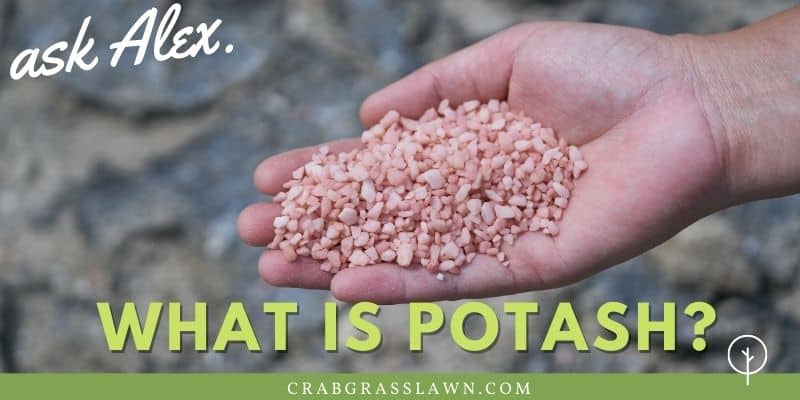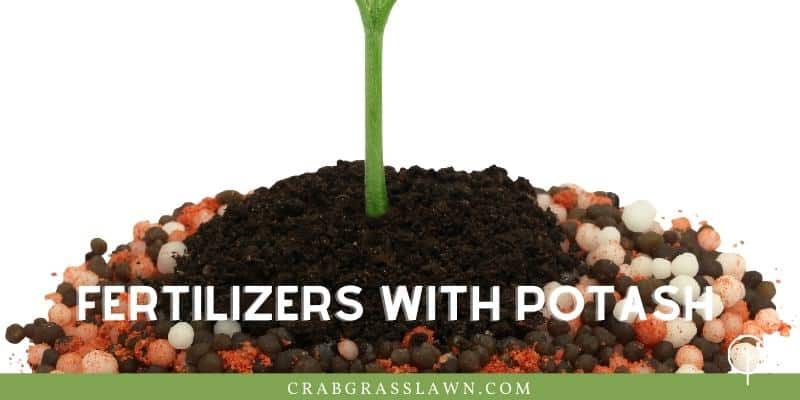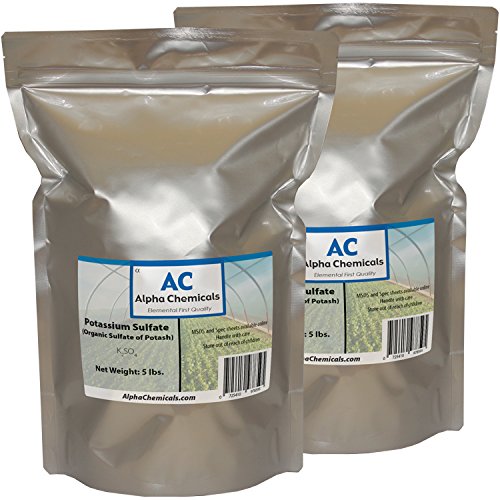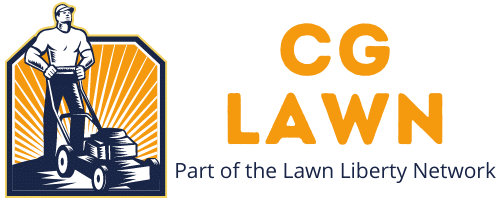When looking up the ingredients in fertilizers, then you probably have come across the word potash.
One of the common questions I receive at CrabgrassLawns is what is potash and what is used for. Potash is one of the three primary nutrients required by plants, along with nitrogen and phosphorus. It is used to provide plants with a readily available source of potassium, which is essential for optimal plant growth.
Read on to find out what exactly is potash, how it works and the many ways it can improve lawn health.
What Is Potash?

Essentially Potash is salt, in water-soluble form, that contains potassium. It is a term used in the fertilizer industry to refer to potassium chloride or potassium sulfate, nitrate, and oxide. Potash is the most common source of potassium used in the agriculture industry. Potassium is the K in N-P-K ratios in fertilizer.
What is Potash Fertilizer?
Potash fertilizer is just that, a fertilizer that contains potash content. This type of fertilizer is mined from a variety of geologic potassium salt deposits around the globe.
These salt deposits are processed to remove impurities and converted into a wide range of fertilizers. Potash fertilizers are available in both granular and liquid form, and choosing between the two depends on your gardening needs.
What Is Potash Used For?
Potassium In Agriculture
Potassium is one of the three main macronutrients that are essential for plant and animal life. Along with potassium, the agriculture industry relies on fixed nitrogen and water-soluble phosphorous to enrich and nourish the soil.
These three nutrients (nitrogen. phosphorous, and potash) are necessary for healthy plants and crops and there are no substitutes for these three key nutrients.
The benefits of adding potassium as a fertilizer include:
- Improves root health and development
- Plays a critical role in sustaining turgor pressure in plants.
- Increases resistance to drought by improving water storage capacities
- Increases resistance to frost
- Helps prevent diseases as well as damage from parasites
- Creates added capacity for vitamins and proteins which makes a healthier and more nutrient-dense plant.
Plants show signs of a lack of potassium through a flaccid structure, leaves with yellow edges, slow growth, smaller than average leaf size, and necrosis in leaves.
Potash in Lawn – What Does Potash Do for Grass?

Fertilizers that are known as “winterizers” often have a high level of potash in their mix. This is because potassium is known to improve cold hardiness in plants including lawns. Potash can also improve the grass’s capacity to resist drought, stress, and disease.
While fall is a great time to apply potash as a fertilizer to repair summer damage and depletion, potash can be used year-round as the benefits of adding potassium to a lawn depleted of this nutrient can be seen in all seasons.
Potash is a health booster for lawns, and lawns that are low in potassium can result in slow growth, yellowing leaves, and poor root development. The lawn low in potassium will also be more sensitive to temperature changes as well as prone to disease.
It can be hard to know if your lawn has low levels of potassium. The only real way of finding out nutrient levels is through a soil test. These tests, either performed with a pH meter or by professionals will give you recommendations for what types of fertilizers your soil needs and in what quantities to produce the healthiest lawns.
Potassium can be found in high levels in many types of soil naturally. However, the potassium in the soil is often in forms that plants are unable to absorb.
Clay soils usually have higher levels than sandy soils, however, as the nutrient is easier to leach out of the sandy soil. Soil testing can best explain if Potassium (in K+ form) is present in adequate levels in the soil, or if additional potassium and other nutrients are needed.
What Is the Difference Between Potash and Sulphate of Potash?
Potash is an umbrella word used to describe a wide range of potassium-containing fertilizers. Potassium sulfate also called sulfate of potash is an inorganic compound with the formula K2SO4.
What Is Sulfate of Potash Used For?
Potassium sulfate is commonly used in fertilizers and provides a blend of potassium and sulfur.
Potash sulfate is a great fertilizer to apply to your garden before and during winter and makes fruits taste better, strengthens cell walls, and gives your flowers great color and bloom in spring.
Several plants benefit from sulfate of potash including vegetables and tomatoes, flowers and shrubs, fruit trees and bushes. It can also be used as a liquid feed, where you simply dissolve it in water and apply it.
What Is the Difference Between Potash and Muriate of Potash?
As mentioned earlier, potash is a general term used to describe a myriad of different K-containing agricultural fertilizers. Potassium chloride KCL is often referred to as muriate of potash, where muriate is an old name for any chloride-containing salt.
Muriate of potash contains 60 percent potash, making it a high source of potassium content. The color of the muriate of potash can vary from red to white, where the reddish tint stems from trace amounts of iron oxide. However, there are no agronomic differences between the two colors.
What Is Muriate of Potash Used For?
Muriate of potash stimulates the growth of strong stems and provides plants with the ability to fight diseases by promoting the thickness of the outer cell walls.
It is the most commonly used potash fertilizer and is particularly good for chloride-loving plants and vegetables such as sugar beets, corn, and celery.
Muriate of potash is also beneficial for soil that’s low in chloride, which enhances the plant’s disease resistance.
Source of Potash
The main sources of potash are in the clay minerals of the soils and rocks, in the ocean waters, and rock salt deposits.
What Is a Good Source of Potash?
A good source of potash is clay minerals in the waters of the oceans and in the crystallized minerals from long dried-up seas.
Potassium salts, which are chloride, sulfate, and nitrate derived from evaporite rocks and salt pans in certain parts of the world are the most common sources of potash.
What Is a Natural Source of Potash?
There are a plethora of different sources of potash including compost, wood ash, kelp meal, greensand, and granite dust.
Compost – compost is loaded with nutrients including potassium, especially when beefed up with fruit and vegetable waste. Another noteworthy feature of compost is that the potassium compounds in it are water soluble, making them readily available to plants.
Wood ash – hardwood ashes are the original source of potash fertilizers and can be used directly as a fertilizer. Hardwood ashes also increase soil pH, which is why it’s important to test your soil regularly to make sure it’s at a balanced pH.
Kelp meal – Available as liquid and dried, seaweed and kelp provide potassium directly to the soil in a quick-release form.
Greensand – Rich in several minerals including potassium, greensand offers twofold benefits – can be used as a fertilizer and soil conditioner.
Best Fertilizers With Potash

When it comes to lawn fertilizers with Potash, you will likely find Potassium Sulfate, also known as SOP, or Muriate of Potash (Potassium Chloride), which is also known as MOP. You are likely to find that most commercial fertilizers are using MOP. Some homeowners and businesses (such as golf courses) prefer to use SOP and find that it is less harsh on lawns. I have listed a couple of recommended options below.
Click through the text or images below to find further product information on these fertilizers. I have found a few good potash products on sale at DoMyOwn and Amazon. Feel free to check these out.
TurfGrass Pro 0-0-29

TurfGrass Pro is a high-potassium liquid potash-packed fertilizer. Coming in with 0-0-29 on the NPK scale. This is a great product for foliar applications and offers a low risk for phytotoxicity. Get It here.
Alpha Chemicals Potassium Sulfate
- A good source of potassium and sulfur
- Shipped in a resealable bag that is sealed for safety and freshness. It includes a tear-off tab for easy opening.
Affiliate links and images pulled from the Amazon Product Advertising API on: 2024-04-18
Where To Buy Potash?
It’s easy to get your hands on potash including soluble potassium, potassium magnesium sulfate, and potassium carbonate at your nearest garden center, agricultural fertilizer store, or online.
Most hardware stores will carry fertilizer with potash or by itself in liquid or granule form.
Once you’ve performed a soil test, you will be able to determine the type of potash your lawn and plant nutrients your soil needs, and the amount for application for healthy crop yields.
History of Potash

The word potash comes from “pot ash” which refers to the way it was originally made in the 1700s.
It was first made from forest ash. Wood ash was mixed with water and then boiled in a large pot, or kettle until the moisture completely evaporated.
What was left became known as black salts. The potash created in this method was a highly demanded world commodity as it was used for making things like soap, glass, fertilizer, and fabric dye, and was used in the processing of wool. In current times potash is used mainly as fertilizer for crops and in biofuels.
Potash Is in Your Food
Yes, you heard that right! Potash is in your food. There’s plenty of potash in a wide range of foods including fruits and vegetables.
Other potash-enriched foods include beets, potatoes, spinach, beans, avocado, and bananas. Just like plants, potash is an essential mineral needed by all tissues in your body.
Organic Alternatives to Potassium
Researchers from China and Brazil are working on alternatives for potassium and they’ve come up with feldspar – a potassium-bearing rock that can be ground into a fine powder that increases soil interaction to release potassium.
The results of feldspar are positive, which apart from potassium uptake also offers other benefits.
FAQs
Q. What Is the Difference Between Potassium and Potash?
A. Potash is a general term used to describe different types of potassium-rich fertilizers. It is derived from the rocks by separating the salt and other minerals.
Q. Are Potash and Limestone the Same Thing?
A. Potash and limestone are two different kinds of rocks. Potash consists of sedimentary minerals and is water-soluble whereas limestone is not water-soluble.
Q. How Long Does It Take Potash Fertilizer to Breakdown in the Soil Enough for Crops to Take up the Potassium?
A. Potash fertilizer can take several weeks or months to break down into the soil and be taken up by the plants.
Final Thoughts
Potash is an essential nutrient for plants and helps improve plant growth and provides disease resistance. You can buy potash fertilizers at your local garden center or online but it’s important to perform a soil test before application.
References and Further Reading on Potash
- PennState Extension. (2016). Turfgrass fertilization: A beginner’s guide. https://extension.psu.edu/turfgrass-fertilization-a-basic-guide-for-professional-turfgrass-managers
- Investopedia. (2020). 5 things to know about Potash. https://www.investopedia.com/financial-edge/1110/5-things-to-know-about-potash.aspx#:~:text=Potash%20is%20America’s%20first%20industrial,farming%20to%20fertilize%20food%20supply.
- USGS. Potash Statistics and Information. https://www.usgs.gov/centers/nmic/potash-statistics-and-information
- USGS. (2020). Potash. https://pubs.usgs.gov/periodicals/mcs2020/mcs2020-potash.pdf
- MIT News. (2015). Seeking potash alternatives. https://news.mit.edu/2015/seeking-potash-alternatives-1102
Hi, Alex Kuritz here. Growing up I remember that my family had one of the best lawns in the neighborhood. Richly green and lush. I did a lot as I grew up in terms of caring and tending for not only my family’s lawn but also my neighbors. I can say I have years of experience, and I am here to share it with you.



